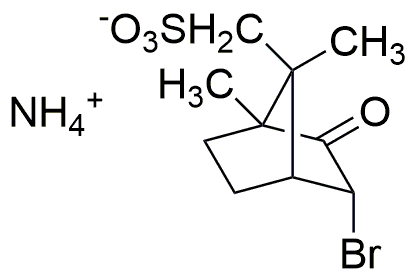(-)-3-Bromocamphor-8-sulfonic acid ammonium salt is widely utilized in research focused on:
- Organic Synthesis: This compound serves as a versatile reagent in organic synthesis, particularly in the development of complex molecules. Its unique structure allows for selective reactions, making it valuable for chemists aiming to create specific compounds.
- Chiral Catalysis: It is employed in asymmetric synthesis, providing chiral environments that enhance the production of enantiomerically pure compounds. This is crucial in pharmaceuticals where the efficacy of a drug can depend on its chirality.
- Biochemical Research: The compound is used as a tool in biochemical assays to study enzyme activity and interactions. Its ability to modify biological pathways makes it an important asset in drug discovery and development.
- Analytical Chemistry: It is utilized in chromatography as a chiral stationary phase, aiding in the separation and analysis of racemic mixtures. This application is essential for quality control in pharmaceutical manufacturing.
- Material Science: The ammonium salt form can be incorporated into polymer matrices to enhance properties such as thermal stability and mechanical strength, making it beneficial for developing advanced materials.
General Information
Properties
Safety and Regulations
Applications
(-)-3-Bromocamphor-8-sulfonic acid ammonium salt is widely utilized in research focused on:
- Organic Synthesis: This compound serves as a versatile reagent in organic synthesis, particularly in the development of complex molecules. Its unique structure allows for selective reactions, making it valuable for chemists aiming to create specific compounds.
- Chiral Catalysis: It is employed in asymmetric synthesis, providing chiral environments that enhance the production of enantiomerically pure compounds. This is crucial in pharmaceuticals where the efficacy of a drug can depend on its chirality.
- Biochemical Research: The compound is used as a tool in biochemical assays to study enzyme activity and interactions. Its ability to modify biological pathways makes it an important asset in drug discovery and development.
- Analytical Chemistry: It is utilized in chromatography as a chiral stationary phase, aiding in the separation and analysis of racemic mixtures. This application is essential for quality control in pharmaceutical manufacturing.
- Material Science: The ammonium salt form can be incorporated into polymer matrices to enhance properties such as thermal stability and mechanical strength, making it beneficial for developing advanced materials.
Documents
Safety Data Sheets (SDS)
The SDS provides comprehensive safety information on handling, storage, and disposal of the product.
Product Specification (PS)
The PS provides a comprehensive breakdown of the product’s properties, including chemical composition, physical state, purity, and storage requirements. It also details acceptable quality ranges and the product's intended applications.
Certificates of Analysis (COA)
Search for Certificates of Analysis (COA) by entering the products Lot Number. Lot and Batch Numbers can be found on a product’s label following the words ‘Lot’ or ‘Batch’.
*Catalog Number
*Lot Number
Certificates Of Origin (COO)
This COO confirms the country where the product was manufactured, and also details the materials and components used in it and whether it is derived from natural, synthetic, or other specific sources. This certificate may be required for customs, trade, and regulatory compliance.
*Catalog Number
*Lot Number
Safety Data Sheets (SDS)
The SDS provides comprehensive safety information on handling, storage, and disposal of the product.
DownloadProduct Specification (PS)
The PS provides a comprehensive breakdown of the product’s properties, including chemical composition, physical state, purity, and storage requirements. It also details acceptable quality ranges and the product's intended applications.
DownloadCertificates of Analysis (COA)
Search for Certificates of Analysis (COA) by entering the products Lot Number. Lot and Batch Numbers can be found on a product’s label following the words ‘Lot’ or ‘Batch’.
*Catalog Number
*Lot Number
Certificates Of Origin (COO)
This COO confirms the country where the product was manufactured, and also details the materials and components used in it and whether it is derived from natural, synthetic, or other specific sources. This certificate may be required for customs, trade, and regulatory compliance.


